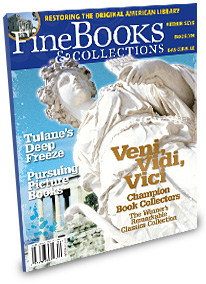
THE WRITE STUFF FB&C welcomes your comments, kudos, complaints, counsel, and silly photos. Send letters to letters@finebooksmagazine.com. Or write us at Letters, FB&C, PO Box 106, Eureka, CA 95502. Sending us a letter constitutes permission to publish it. Letters may be edited for reasons of space and clarity.
Rebecca Rego Barry, in “The Greatest Gatsby” (FB&C #28), quotes Charles Scribner III as saying that the “motivation to create the new text, a definitive edition [of the Great Gatsby] with textural alterations, was a financial one, not a scholarly one…It is not because we thought the current editions were corrupt.”
Then why did Scribner use my Cambridge University Press (CUP) critical edition of the text from 1995 to 2004, through at least thirty-six printings of the “authorized text?” And why did Scribner replace the CUP text, for which they were paying a miniscule royalty, with a foul text with fifty-eight wrong readings for which they are paying no royalty?
Of course it was about money for Scribner. It should be about respect for a masterpiece. It is about responsibility for the books that bear your name. The texts of the Scribner editions of F. Scott Fitzgerald’s Tender Is the Night and Thomas Wolfe’s Look Homeward, Angel are worse than Gatsby.
Matthew J. Bruccoli
Bruccoli Clark Layman
Columbia, South Carolina
I never subscribed to your publication, and I have no idea why I get it, but I am very happy to receive it. Don’t stop.
The latest issue, with its emphasis on Hollywood, is sure to be a classic. The matter of alteration of text and adaptation is something I stumbled on in researching an entirely different subject. Purists always regret when a literary work is adapted for the screen or a “classic” movie is remade. Sometimes the regret is justified, but not always. It seems Edgar Rice Burroughs, Inc. once objected to changes which were being made to the Tarzan movies, but it turned out the contract gave the movie producer the right to “update” the story. I call this the Nancy Drew running-board problem. In early texts, Nancy was known to jump onto the running board of a car. Well, automobiles are no longer made with them. Does the tale remain unchanged and become quaint or is the story changed to reflect a different world? Both alternatives are unsatisfactory in different ways.
A. Merritt (an author of fantastic fiction) was known for blessing changes as his works were reprinted, even if he didn’t always make the changes himself. The nationalities of the villains switched back and forth between Russian and German to reflect the political climate. In an early version of The Moon Pool (first published in 1919), a hero was in the Royal Naval Air Service, but as the United Kingdom reorganized its military, in later editions he was in the RAF. Yes, minor stuff, but still necessary to note.
Correcting obvious typos, as in the Great Gatsby, is one thing. Beyond that it’s murky ground for editors. With authors involved, there is the additional temptation to rewrite one’s work to make it better—witness the New York edition of Henry James. Maybe in future issues, you can expand on these matters.
J. B. Post
Paoli, Pennsylvania
You are not the only librarian puzzled over the unannounced arrival of Fine Books in your mailbox. We made arrangements to send the magazine free to all the members of the rare books and manuscripts section of the American Library Association. We are very glad that you and your colleagues enjoy the magazine. Please consider it a small thank-you for all the work you do preserving and promoting antiquarian books.
We appreciate your suggestion about running more stories about changes to the texts of books. It’s an interesting topic and a good argument for collecting more than just first editions. Our most substantial story on the subject came in issue #11, where Anne Trubek explored the various versions Theodore Dreiser published of Sister Carrie.–Ed.
I was delighted to find the article by Pasco Gasbarro (“Twelve Great Movies Every Book Collector Should See”) in the July/August issue (#28). It was a very pleasant surprise since I was not aware that movies such as The Big Sleep or Fahrenheit 451 were about books.
However, I would like to point out that the book shown in The Ninth Gate is, in fact, Ibarra’s 1780 Don Quixote in four volumes with engravings by various contemporary Spanish artists. It’s not, as you wrote, some “nineteenth-century Don Quixote illustrated by Gustave Doré.”
Marie Zurenda
Miami, Florida
It is probably karma that our story poking fun at Hollywood’s mistakes where it comes to antiquarian books included several errors of our own. As you pointed out, Roman Polanski’s film The Ninth Gate did, in fact, use a real copy of the exquisite Joaquin Ibarra edition of Don Quixote as a prop. Polanski confirms this fact in his director’s commentary on the DVD release of the film. We also opined that the book at the center of the film looked to be engraved when it should have been illustrated by woodcuts. The book, titled Novem Portis, doesn’t quite look authentic, but given its imagined date of publication, 1666, it probably would have had engravings as illustrations, not woodcuts. In our summary of The Big Sleep, we suggest that Philip Marlowe (played by Humphrey Bogart) consults an Elkin Matthew’s catalog in the library scene. While the title of Matthew’s catalog is similar to the book seen in the movie, Joel Silver (“Beyond the Basics,” this issue) correctly points out that the reference Bogart uses does not really exist. To say that Pasco and I regret the errors would be an understatement. Please accept our apologies.–Ed.


